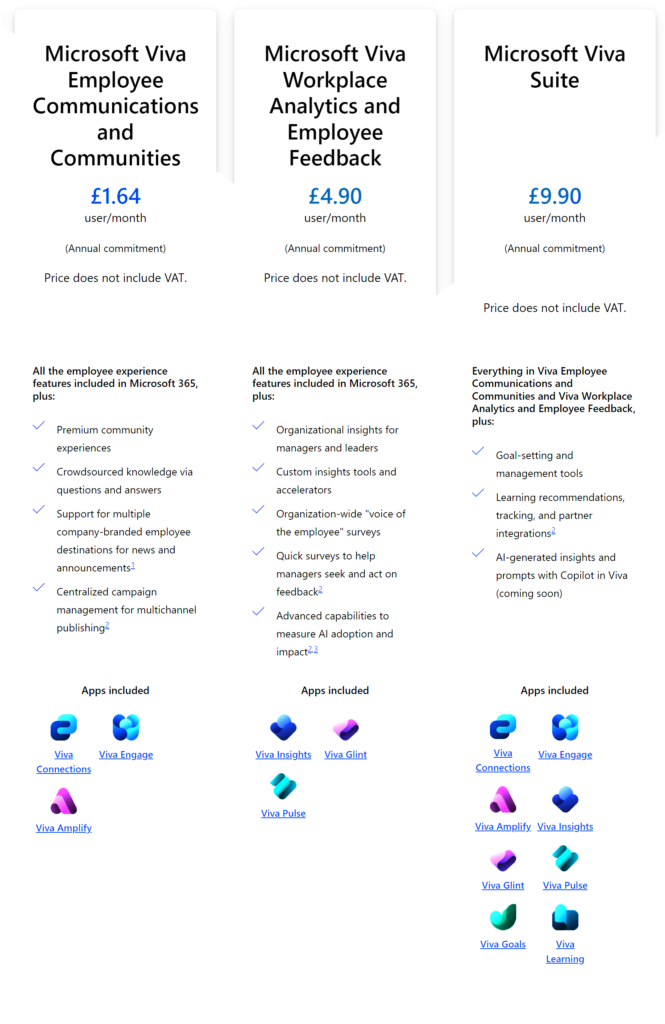Background
The first response to my latest post on Viva Amplify was “Shame it requires an additional subscription, and not bundled in the E3/E5 SKU”.
With every additional add-on SKU for a Microsoft 365 service there is always the question of whether the capability should be a core offering. In this post we’ll answer the question, how is Viva Amplify Licensed?
Base Licenses
How is Viva Amplify Licensed? Before looking specifically at Viva licensing, I’ll take some time to run through how I interpret the base Microsoft license SKUs.
- Microsoft 365 E3: Larger clients will use this SKU if they have a mix of vendors in their estate. For example, they will use Microsoft 365 for productivity apps, SharePoint and OneDrive for data storage, and Exchange Online for mail. They might use Teams for communication, but they might primarily be Zoom or Webex users. They will have a third party threat and vulnerability management solution, such as CrowdStrike.
- Microsoft 365 E5: Clients will use this SKU if they are all in on vendor consolidation and want to really want to make the most of their Microsoft investment. On top of the capabilities used in E3, they will be using Teams as their primary real time communication platform and will be using Defender for Endpoint Plan 2 as their threat and vulnerability management solution. This will probably be backed by a Microsoft Sentinel SIEM solution. They will also be using the Purview features extensively to protect their data and support data loss policies.
Other SKUs
Then there are the frontline plans, F1 and F3, that will be used dependant on the use case and how they will access services.
Further, there are use case specific SKUs such as standalone Exchange Online.
Finally, there are the add-ons. These provide features over and above the base capabilities of what a business, charity or school will need to operate effectively. For example, Copilot is an extreme case that falls into this category. Not everyone is going to benefit from these capabilities in their role, and there may be existing business processes, tools that offer similar capabilities. Rollout and deployment of services like this also take a lot of consideration preparation (that’s for another post). Copilot is an extreme example as you can’t shy away from the cost!
Introduction
Viva Amplify falls into the category of an add-on. It sits in two add-ons, Microsoft Viva Employee Communications and Communities, or the Microsoft Viva Suite. The bundle you will need will depend on the capabilities you plan to leverage. For example, if you are going to be using Viva Learning as your home for online learning, and Viva Pulse for quick surveys and feedback for line managers and leaders, you will probably see value in Viva Suite. If, however, you are only focused on employee communication, and already have a mature e-learning platform, you will see sufficient capabilities in the Microsoft Viva Employee Communications and Communities SKU. There are of cause more capabilities and features in Viva Suite that might make it a compelling investment.
Equally, as a business, you might already have a strong internal communication team that already has a means of getting telemetry from outbound user communications, and there may be no need for extra tooling.
How is Viva Amplify licensed?
Focusing on Viva Amplify, the licensing is straightforward. Anyone creating, or consuming content, requires a license. For example, if you are a HR department creating an all-staff communication, all of the recipients will need a Microsoft Viva Employee Communications and Communities, or Viva Suite license, regardless of whether they are a knowledge worker (with an E3/E5 base license) or a frontline worker (with an F1/F3 base license).
If, however, you were only targeting users in specific regions, or teams, you could license just those users. This will create an administrative overhead to manage, as there from the testing I’ve done so far, there is no recipient validation to ensure they are compliant. This behaviour seems to be similar to that of Entra ID P2, where you buy one license, and the capabilities are opened up to the whole tenant. It’s up to the administrators to ensure compliance. At the time of writing I couldn’t find anything to support this assumption!
